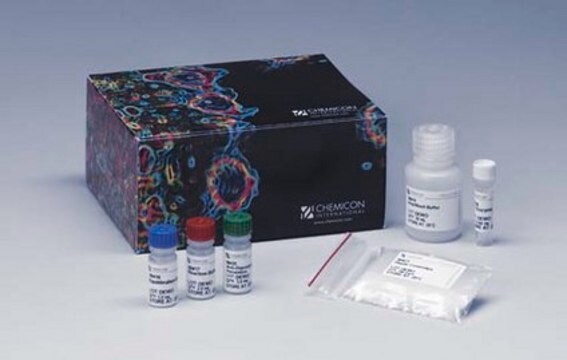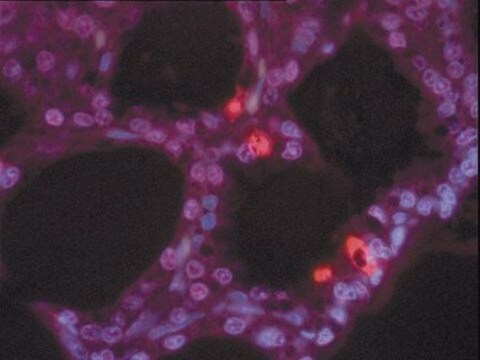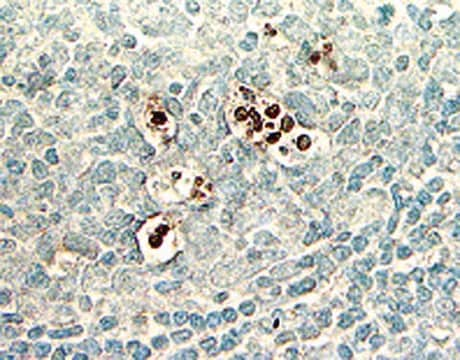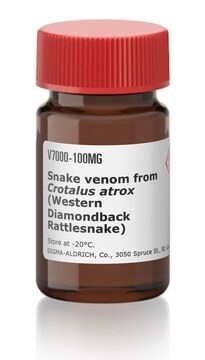S7107
ApopTag TdT Enzyme
ApopTag Terminal deoxynucleotidyl Transferase (TdT) is a recombinant enzyme intended for use in labeling the 3′-OH ends of fragmented DNA during apoptotic cell detection.
Sinônimo(s):
TdT enzyme, Terminal deoxynucleotidyl transferase
Faça loginpara ver os preços organizacionais e de contrato
About This Item
Código UNSPSC:
12161503
eCl@ss:
32161000
NACRES:
NA.84
Produtos recomendados
Descrição geral
ApopTag Terminal deoxynucleotidyl Transferase (TdT) is a recombinant enzyme intended for use in labeling the 3′-OH ends of fragmented DNA during apoptotic cell detection. Qualified for use with Apoptag In Situ Apoptosis Detection Kits (Catalog #s: S7100, S7101, S7110, S7111, S7160 and S7165).
ApopTag is a registered trademark of Serologicals Company.
ApopTag is a registered trademark of Serologicals Company.
Aplicação
Materials Provided:
Each vial contains 300 μl of ApopTag Terminal Transferase (TdT) Enzyme.
Instructions for Use
Prepare labeling mixture as follows:
77 μl ApopTag Reaction Buffer (S7105 or kit component # 02)
33 μl ApopTag TdT Enzyme
Mix well and keep on ice. This reagent may be prepared in advance and stored on ice for no more than 6 hours. The Reaction Buffer - TdT Enzyme mixture is ready for use at the "APPLY WORKING STRENGTH TdT ENZYME" step in The Complete ApopTag Manual.
Warnings and Precautions :
ApopTag Terminal Transferase (TdT) Enzyme contains potassium cacodylate (dimethylarsinic acid) as a buffer. This material is harmful if swallowed; avoid contact with skin and eyes (wear gloves, glasses); wash areas of contact immediately.
Each vial contains 300 μl of ApopTag Terminal Transferase (TdT) Enzyme.
Instructions for Use
Prepare labeling mixture as follows:
77 μl ApopTag Reaction Buffer (S7105 or kit component # 02)
33 μl ApopTag TdT Enzyme
Mix well and keep on ice. This reagent may be prepared in advance and stored on ice for no more than 6 hours. The Reaction Buffer - TdT Enzyme mixture is ready for use at the "APPLY WORKING STRENGTH TdT ENZYME" step in The Complete ApopTag Manual.
Warnings and Precautions :
ApopTag Terminal Transferase (TdT) Enzyme contains potassium cacodylate (dimethylarsinic acid) as a buffer. This material is harmful if swallowed; avoid contact with skin and eyes (wear gloves, glasses); wash areas of contact immediately.
Embalagem
1000 units/mL
Armazenamento e estabilidade
Recommended Storage -15°C to -25°C.
Informações legais
CHEMICON is a registered trademark of Merck KGaA, Darmstadt, Germany
Exoneração de responsabilidade
Unless otherwise stated in our catalog or other company documentation accompanying the product(s), our products are intended for research use only and are not to be used for any other purpose, which includes but is not limited to, unauthorized commercial uses, in vitro diagnostic uses, ex vivo or in vivo therapeutic uses or any type of consumption or application to humans or animals.
Palavra indicadora
Danger
Frases de perigo
Declarações de precaução
Classificações de perigo
Aquatic Chronic 2 - Carc. 1B
Código de classe de armazenamento
6.1C - Combustible acute toxic Cat.3 / toxic compounds or compounds which causing chronic effects
Classe de risco de água (WGK)
WGK 3
Certificados de análise (COA)
Busque Certificados de análise (COA) digitando o Número do Lote do produto. Os números de lote e remessa podem ser encontrados no rótulo de um produto após a palavra “Lot” ou “Batch”.
Já possui este produto?
Encontre a documentação dos produtos que você adquiriu recentemente na biblioteca de documentos.
Os clientes também visualizaram
Po-Nien Tsao et al.
Development (Cambridge, England), 136(13), 2297-2307 (2009-06-09)
Although there is accumulated evidence of a role for Notch in the developing lung, it is still unclear how disruption of Notch signaling affects lung progenitor cell fate and differentiation events in the airway epithelium. To address this issue, we
Divya A Shiroor et al.
Current biology : CB, 30(11), 2166-2174 (2020-05-11)
Stem cells are continuously exposed to multiple stresses, including radiation and tissue injury. As central drivers of tissue repair and regeneration, it is necessary to understand how their behavior is influenced by these stressors. Planarians have an abundant population of
Nossa equipe de cientistas tem experiência em todas as áreas de pesquisa, incluindo Life Sciences, ciência de materiais, síntese química, cromatografia, química analítica e muitas outras.
Entre em contato com a assistência técnica











